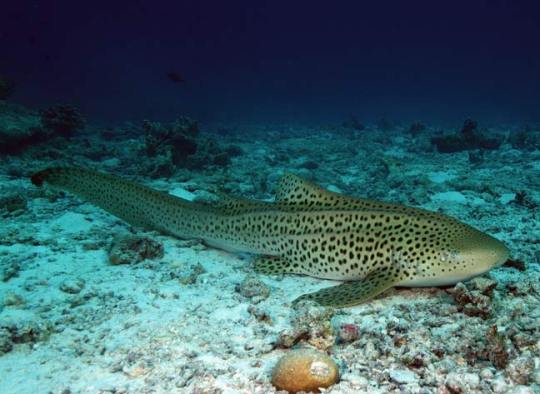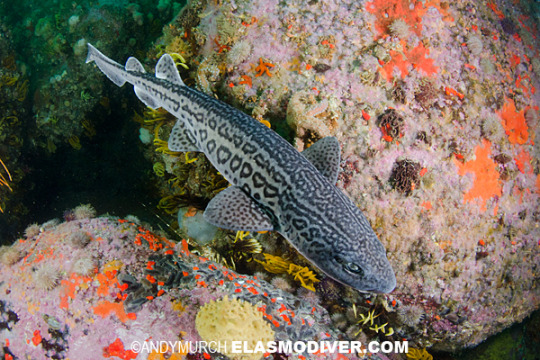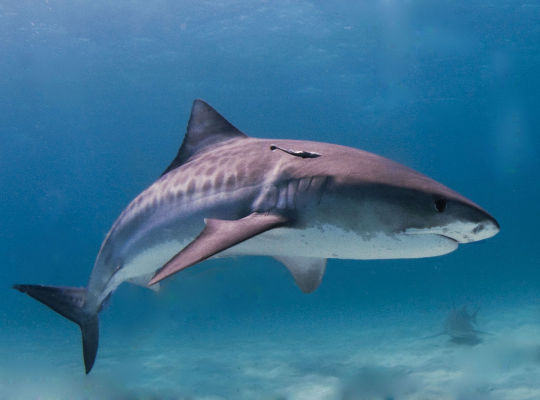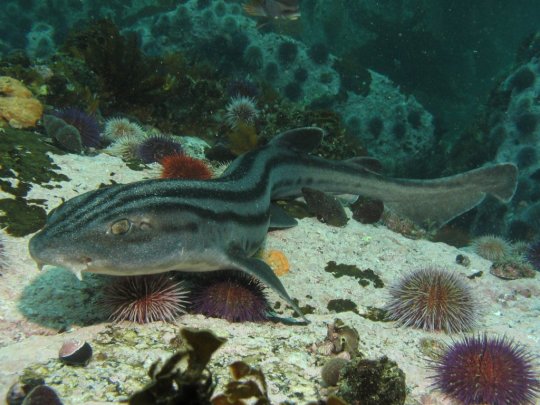#poroderma
Explore tagged Tumblr posts
Text

Leopard Catshark (Poroderma pantherinum), family Scyliorhinidae, endemic to the south African coast
Photograph by Andy Murch
388 notes
·
View notes
Text

Repostober 17; some sleepy pyjama sharks from 2014
2K notes
·
View notes
Text
'If only there were an annular snack I could eat by itself or with a dollop of the spread of my choosing'
The humble bagel:

(Shark waffling under the cut)
This curled posture we see in the pyjama sharks shown is a pretty common defensive mechanism found in many smaller sharks. In fact, the common name of genus haploblepharus, shysharks, is supposedly a reference to this position.
Pyjama sharks are very opportunistic predators as well as prey items for larger sharks, especially broadnose sevengill sharks which inhabit the same kelp forests. Interestingly, it has often been observed that these sharks favour cephalopods; they can be found near the spawning grounds of chokka squid and have been filmed tearing the arms of common octopuses with a 'death roll', not unlike crocodilians.
For anyone concerned about the bottom right image, this was taken from iNaturalist with the original observation stating that the shark was tagged and released. This behaviour in these images is a stress response, but to the best of my knowledge this is due to proximity to photographers - these sharks are regarded as 'difficult to approach underwater' and are classed as Least Concern by the IUCN
Information taken from Fishbase and the IUCN website, photos taken from iNaturalist
#Behold! A thinly veiled excuse to talk about my favourite shark instead of studying!#Sharkblr#Shark#Pyjama shark#Poroderma Africanum#Fish#Own post
78 notes
·
View notes
Text
Fish of the Day
Today's fish of the day is the pajama shark!

The pajama shark, also known by scientific name Poroderma africanum, is known mostly by divers along Cape Town. These animals are a kind of catshark, a family defined by egg laying and bottom feeding. With a range along the coast of Southern Africa, they stretch from Table bay to East London, found most prominently off of the Western Cape. Historical records imply at one point there may have been a population in Madagascar, but currently there are no signs this population still exists.

These fish live in shallow waters, getting as deep as 16ft, although in areas with rocky shores, they have been found as deep as 150-300ft, with a strong preference for intertidal locations with nearby kelp forests.. The diet of the pajama shark is made up of bony fishes, smaller rays or sharks, crabs, lobster, cephalopods. In particular pajama sharks have been seen hiding among squid eggs, and ambushing descending parents. They have also been seen ambusing octopi in their area as well, grabbing them and twisting to tear off tentacles larger than the pajama shark's body. They can get as large as 4 ft in length, on the midrange for catsharks.

They have no breeding season, instead having sexual events year round. one pup can be made at a time and eggs are hidden underwater, and covered in algae of kelp to remain hidden. The eggs will take 5-6 months to hatch, after which pups will measure only 14-15 inches long. They will mature sexually by the time they reach 30-35 inches in length, and can live up to 5 years. They hunt in daylight until sexual maturity, at which point they shift schedule, primarily hunting at night, finding places among kelp to rest during the day

Have a wonderful day, everyone!
#fish#fish of the day#fishblr#fishposting#aquatic biology#marine biology#animal facts#animal#animals#fishes#informative#education#aquatic#aquatic life#nature#river#ocean#shark#sharks#pajama shark#Poroderma africanum#catshark
40 notes
·
View notes
Note
Got facts about pyjama sharks? They are very cute :)

Pyjama shark or striped catshark (Poroderma africanum).
You're 100% right, they're absolutely adorable. These little guys only grow to be approximately 1.1 m (3.6 ft) long. These sharks are primarily nocturnal and hunt small fish, crustaceans, and shark egg cases. They capture prey the same way that crocodiles do! They'll bite onto their prey and roll to disorient and kill it.

These sharks are endemic to the waters of the South Africa coast (aka, that's the only place they're found in the wild). The biggest threat to their population is being caught as bycatch. The good news is that their populations are believed to be increasing and their conservation status is that of least concern!
#marine biology#science#biology#animals#marine ecology#fish#Shark#sharks#pyjama shark#striped catshark#ocean#oceans#sea#sea life#sea creatures#ocean life#ocean animals#sea animals#earth#biodiversity#fun fact#fun facts#animal facts#cool facts#zoology#cute animals#cute animal
375 notes
·
View notes
Note
Trick or treat! 🎃💕
I'll give you a nice pyjama shark (Poroderma africanum)!

73 notes
·
View notes
Note

Crab for a fish?
A fine trade :)

You get a Pajama Shark
Poroderma africanum
51 notes
·
View notes
Note
Hi! I love your blog, your posts seem really thoughtful and I'm glad you're educating people about our fantastic sharks! May I ask what you think of Pyjama Sharks? They have been my favourite shark since childhood, and I love them very much
thank you so much, that means a lot to me!
as for the pyjama sharks, i absolutely love them!
Pyjama shark, also known as striped catshark (Poroderma africanum) is named after its stripes that run along its body, making it look like it's wearing pyjamas :]
Fun fact: They curl into little balls when they feel threatened!

(it's still kinda cute, even if they are scared)
They live off the coast of South Africa, and its favorite food is squid :]
In short, I love them and they are so baby <3
Thank you so much for the ask!
Image credit: X
16 notes
·
View notes
Photo

Pyjama Shark Poroderma africanum
#poroderma africanum#poroderma#pyjama shark#shark#chondrichthyes#elasmobranch#elasmobranchii#fish#icthyology#marine#marine life#marine biology#ocean life#animal#animalia#zoology#aquatic#catshark#ground shark#carcharhiniformes#scyliorhinidae#nature#stripes
673 notes
·
View notes
Note
In certain parts of the world, the Zebra shark is called the Leopard shark. And the vice versa goes for the Leopard Shark.

In order from top to bottom (not including my man Bernie Sanders):
Stegostoma tigrinum (Orectolobiformes; Stegostomatidae):

Triakis semifasciata (Carcharhiniformes; Triakidae):

Poroderma pantherinum (Carcharhiniformes; Scyliorhinidae):

Idk which parts of the world you are referring to, but this should illustrate how dumb common names are, whether you are correct or not.
Here, we have S. tigrinum, which looks like a cheetah when it is an adult, but is called a zebra shark (reflecting its striping as a juvenile).
T. semifasciata, which looks like a tiger, but is called a leopard shark (children and adults at aquariums oft call T. semifasciata "tiger sharks").
P. pantherinum, which looks like a leopard and is in the catshark family, and its common name reflects that pleasingly.
Honorable mentions to Helaelurus natalensis (Carcharhiniformes; Scyliorhinidae) for being called a tiger catshark, for being in the catshark family and looking like a tiger.

To Galeocerdo cuvier (Carcharhiniformes; Carcharhinidae) for looking like a tiger and a leopard, but being called a tiger shark.

And to Poroderma africanum (Carcharhiniformes; Scyliorhinidae) for looking like a zebra and being a catshark, but instead breaks free from a common name comparing it to existing land species, and being called, instead, the pyjama catshark.

#chondrichthyes#elasmobranch#selachii#Carcharhiniformes#orectolobiformes#Scyliorhinidae#carcharhinidae#triakidae#Stegostomatidae#stegostoma tigrinum#triakis semifasciata#Galeocerdo cuvier#poroderma pantherinum#halaelurus natalensis#poroderma africanum#tiger shark#tiger catshark#leopard shark#leopard catshark#zebra shark#pyjama catshark#pyjama shark#striped catshark
13 notes
·
View notes
Text

Pyjama Catshark (Poroderma africanum), family Scyliorhinidae, South Africa
photograph by Andy Murch
#Scyliorhinidae#poroderma#shark#catshark#elasmobranch#fish#ichthyology#animals#nature#africa#ocean#marine biology
92 notes
·
View notes
Text

Pyjama Shark (Poroderma africanum)
taken at the Downtown Denver Aquarium in Denver, Colorado
status: near threatened
A beautiful small shark species that only grows to be 2.5 feet in length if male and 3.1 feet if female. They are one of two species of cat shark in the family Poroderma.
#Pyjama Shark#Poroderma africanum#shark#catshark#animal#photo#photography#downtown denver aquarium#aquarium#canon#canon 6d mark ii
58 notes
·
View notes
Text
Allow me to bombard all those unfortunate enough to view this post with information around my most cherished of sharks: the pyjama shark! My blog name is a version of their latin name, but did you know that this version of their name is a bit of a mystery?

(All pictures are from iNaturalist, I take full responsibility for turning this photo into a shitty meme)
Like most sharks on the smaller side (and plenty or large sharks too), pyjama sharks are woefully understudied. A good example is their latin name: poroderma africanum.
The second half is easy enough, 'africanum' referring to the fact that pyjama sharks are endemic to South Africa. Even this isn't quite as straightforward as it seems, since there are (unconfirmed) historical records of pyjama sharks in Madagascar; we currently have no evidence to prove or disprove this.
As for 'poroderma', this can literally be interpreted as 'porous skin'. Why is this so notable in pyjama sharks? Truthfully, I do not know. Like most sharks, they use Ampulla of Lorenzini to sense their surroundings, but as far as we know, there is no reason why the skin of pyjama sharks is particularly noticeable.
To make up for this, all of their common names (Pyjama shark, pyjama catshark, striped catshark) are fairly self-explanatory. Everybody say 'thank you pyjama sharks' for having a cool name
#I am deeply sorry and also deeply sleep deprived please forgive this trainwreak of a thought I have decided to release into the internet#Pyjama shark#Shark#Fish#Sharkblr#Own posts
55 notes
·
View notes
Photo


Pyjama shark (Poroderma africanum)
The pyjama shark is a species of catshark, and part of the family Scyliorhinidae, endemic to the coastal waters of South Africa. This abundant, bottom-dwelling species can be found from the intertidal zone to a depth of around 100 m, particularly over rocky reefs and kelp beds. With a series of thick, parallel, dark stripes running along its stout body, the pyjama shark has an unmistakable appearance. It can grow up to a length of 1.1 m long. The pyjama shark is primarily nocturnal, spending most of the day lying motionless and hidden in a cave or crevice or among vegetation. It often forms groups, particularly during summer. This species is an opportunistic predator that feeds on a wide variety of fishes and invertebrates; it favors cephalopods and frequents the spawning grounds of the chokka squid. When threatened, it curls into a circle with its tail covering its head. Reproduction is oviparous, with females laying rectangular, dark brown egg cases two at a time year-round.
photo credits: Guido Zsilavecz, Illustrations of the Zoology of South Africa
#pyjama shark#Poroderma africanum#shark#zoology#biology#biodiversity#science#wildlife#nature#animals#cool critters
1K notes
·
View notes
Text
Pajama Shark

Matilda’s Lab ©2020. https://twitter.com/matildaslab
View On WordPress
2 notes
·
View notes
